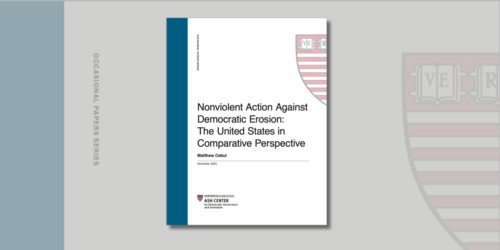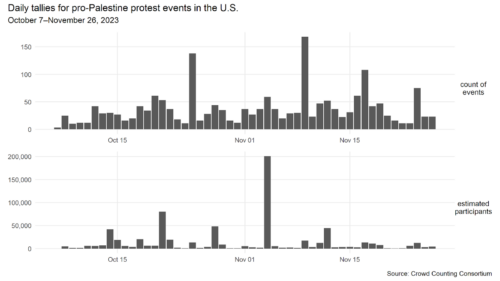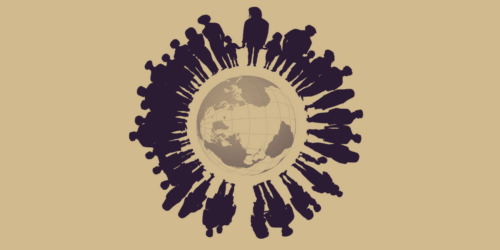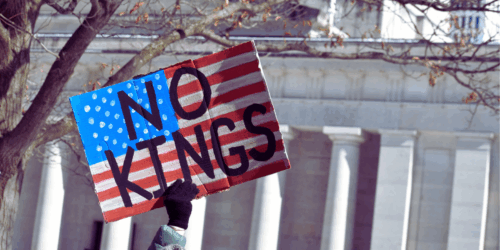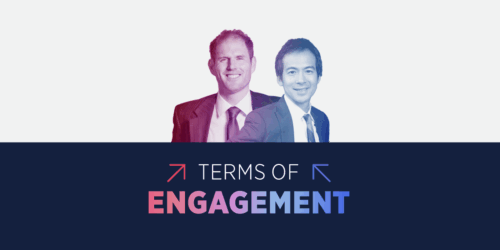Since October 7, the Crowd Counting Consortium (CCC) has recorded nearly 2,300 U.S. protests, rallies, marches, caravans, demonstrations, vigils, banner drops, and direct actions in support of Palestine or Israel, with hundreds of thousands of total participants on different sides of this mass mobilization. While the pace and size of public gatherings in solidarity with Israel have declined significantly since the initial surge, actions in support of Palestine have swelled into a geographically broad and demographically and tactically diverse movement that continues to produce scores of events with thousands of total participants almost every day.
For the period October 7–November 26, CCC has recorded 1,869 pro-Palestine protests, rallies, marches, demonstrations, vigils, banner drops, and direct actions in 468 different cities and towns across 49 U.S. states, the District of Columbia, Puerto Rico, and Guam. We have information about crowd size for 1,060 (57%) of those events, and we conservatively estimate the total crowd size for those 1,060 events at nearly 680,000 people. As shown in the chart below, several coordinated days of action — including a school walkout in late October, a Global Shutdown for Palestine on November 9, and another Shut It Down for Palestine call the Friday after Thanksgiving — have served as focal points for pro-Palestine activism, but we’re still recording scores of events scattered across the country almost every day, and the crowd sizes at them have grown and then held fairly steady.

Over the same period, CCC has recorded 433 pro-Israel rallies, demonstrations, marches, protests, and vigils in 261 different cities and towns across 45 U.S. states and DC. We have information about crowd size for about 70% of those events (305), and we conservatively estimate the total crowd size for that 70% at about 291,000 people. During that time, we’ve seen a shift from large indoor vigils or rallies in response to the initial attacks to smaller demonstrations focused on calls to bring home the hostages taken on October 7. Notably, more than half of all the pro-Israel events we have recorded happened within a week of the October 7 attacks. While many of the actions during that initial surge were organized by faith leaders and local or national Jewish community groups, many of the recent actions have been led by community members and have involved displays in public spaces of empty shabbat tables or empty strollers adorned with posters showing pictures of Israeli hostages. A small fraction of the pro-Israel events we’ve recorded have been led by state or local Republican Party organizations or Christian evangelical groups.

Elected officials ranging from city council members and mayors to state governors and U.S. senators have participated in — or, in some cases, helped to organize — a sizeable share of the pro-Israel events we’ve recorded over the past eight weeks. Our data shows elected officials at 102 (24%) of the pro-Israel events we’ve logged since October 7, and that excludes events that were organized solely by state or local governments, which CCC does not cover. By contrast, elected officials have appeared at pro-Palestine events only rarely: just 20 events, or about 1 percent of the time, through November 26. None of those pro-Palestine appearances by elected officials have involved any U.S. senators or governors, and only a few have involved U.S. representatives (almost all of them by Rep. Rashida Tlaib, Rep. Cori Bush, or both). We have also seen uniformed law enforcement officers participate in some pro-Israel events, something we have not seen at any pro-Palestine actions.
One notable feature of the pro-Palestine movement is the variety of tactics it is employing. While nearly all of the early actions were demonstrations, rallies, marches, or protests on public sidewalks and streets, we’ve also seen a significant increase since mid-October of acts of civil disobedience and other deliberately disruptive actions. Many of these have targeted the offices of U.S. senators and representatives who have not yet expressed support for a ceasefire in Gaza. Others have targeted the offices or other facilities of companies that design or manufacture weapons for the Israeli military, franchises of companies invested in Israel, or public thoroughfares or transit hubs. Over that same time, we have also seen an increasing but still small number of direct actions involving vandalism or other types of property damage at some of those same commercial targets. Taken together, these acts of civil disobedience and direct actions have led to more than 1,600 arrests since October 7, with hundreds of those arrests sometimes occurring at a single event. We have seen reports of property damage at 41 pro-Palestine events (2%), almost all of it graffiti or broken windows, while none of the pro-Israel events we’ve recorded have involved property damage.

Another notable feature of the current pro-Palestine mobilization is its demographic diversity. Unsurprisingly, many of the actions throughout this wave have been led by Palestinian community, youth, and student organizations acting in concert with other Arab-American or Muslim ones. From the start of the wave, those organizations have also been supported by the same diverse array of anti-colonialist, anti-imperialist, anti-racist, anti-capitalist, feminist, and queer organizations that have supported calls for Palestinian liberation for decades. Anti-Zionist or otherwise “progressive” Jewish groups like Jewish Voice for Peace and IfNotNow are also not new, but they have become particularly active in this wave, and they have led many of the large acts of civil disobedience we’ve seen in recent weeks. As the Palestinian death toll in Gaza has climbed, we have also seen more actions in places like Amarillo, Texas, and Irvine, California, that are led by individuals who are not experienced organizers but have nevertheless been moved to act for this cause. Also notable, the crowds in the videos and images we’ve seen from these pro-Palestine events have also ranged widely by race and age, often involving families and including everyone from small children to the elderly. The crowds at many pro-Israel events have also included people of all ages, but they have featured noticeably less racial and ethnic diversity than the pro-Palestine ones.
Since the start of 2022, CCC has also routinely recorded protesters’ demands or other claims from the signs, banners, flags, and chants we see or hear in photos, video, and other reporting from the events we track, allowing us to analyze the nature and evolution of protest rhetoric within and across movements. We don’t always have video or audio evidence from which to capture these claims, but when we do, we record as many unique references as we can. (By “unique,” I mean that we only record a single instance of any given phrase at a particular event, even if it appears more than once.)
In the ongoing pro-Palestine movement, we’ve seen an expansion over the past eight weeks beyond the long-standing focal points of pro-Palestine activism — claims of occupation, apartheid, resistance, and return — to regular references to genocide and the need for a ceasefire in Gaza to stop it. If “free Palestine” and Palestinian flags have been the common thread throughout, the emphasis on other signs and chants has shifted over the course of the current wave from phrases like “end the occupation”, “lift the siege on Gaza”, and “no U.S. aid to apartheid Israel” to things like “ceasefire now”, “stop funding genocide”, “bombing kids is not self-defense”, and “stop killing children”. The former still appear regularly, but they are now often joined by the latter, and a fair share of recent events have focused exclusively on alarm over genocide and calls for an immediate ceasefire.
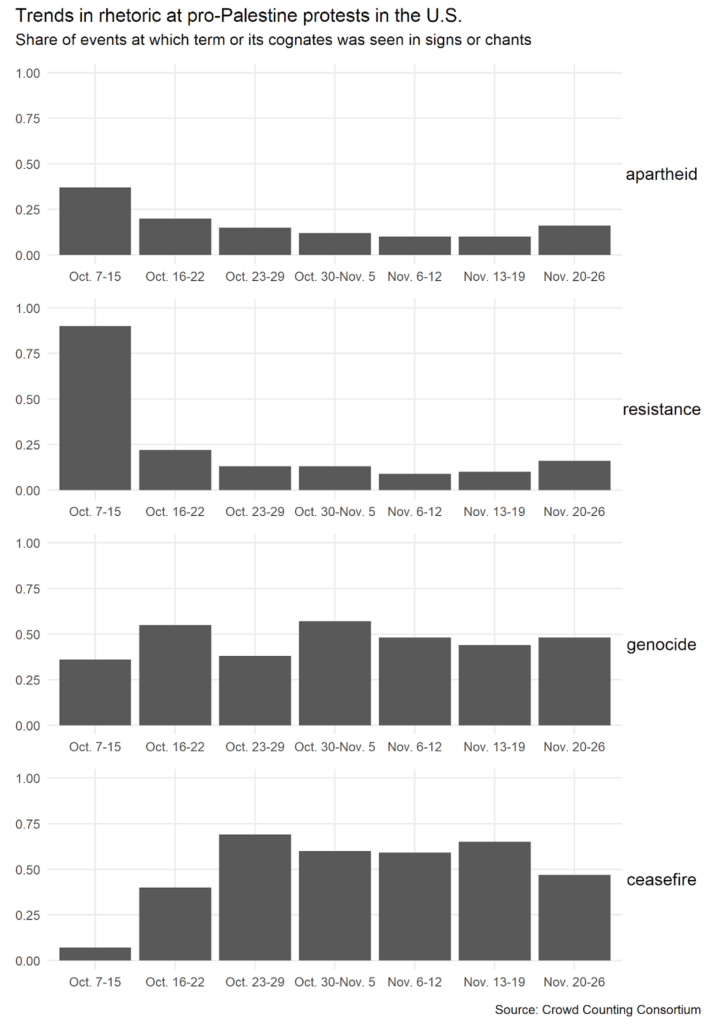
One focal point of the broader politics around this moment and movement has been the frequent use by pro-Palestine protesters of the phrase, “From the river to the sea Palestine will be free!” While many Jewish community organizations and other pro-Israel groups assert that the slogan is inherently antisemitic and threatening because, to them, it necessarily implies the destruction of Israel and killing of its inhabitants, many Palestinians — including some asked by reporters during protests what they intend the phrase to mean — reject that characterization and describe their own use of the phrase as a broader call for Palestinian dignity and liberation. What our data confirm is that this phrase has regularly featured in the rhetoric of recent pro-Palestine actions. As shown in the chart below, we have seen or heard this phrase or just its first part, “from the river to sea”, in images, videos, or other reporting from nearly 400 events since October 7, making it the second most common phrase behind only “free Palestine” and just a bit more common than “ceasefire” or “ceasefire now”.
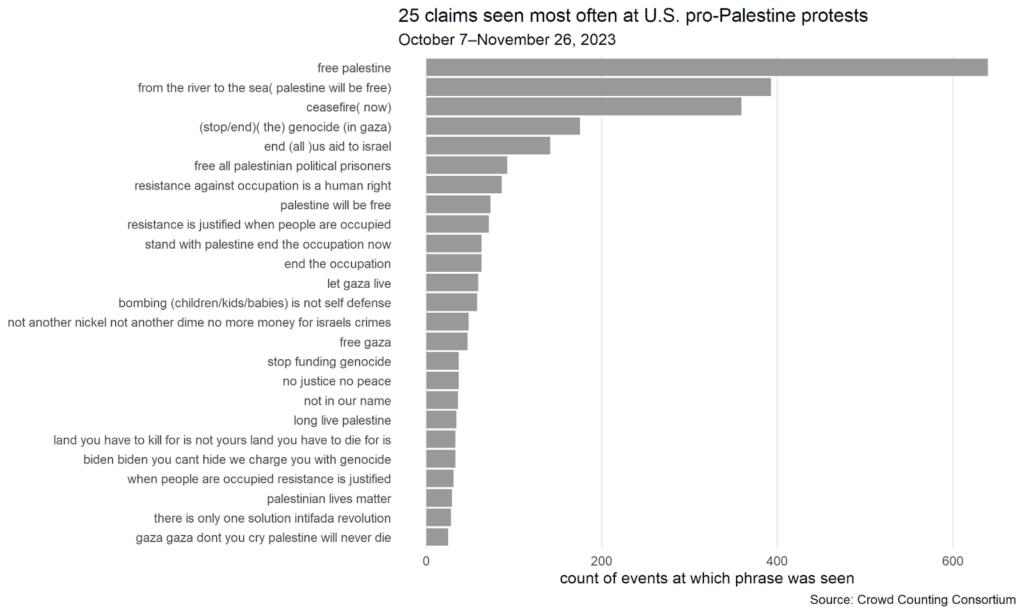
The single-largest events on both sides of this wave so far came in Washington, DC, in November: a rally and march for Palestine centered on Freedom Plaza and the White House on Saturday, November 4, and a March for Israel held on the National Mall just 10 days later, partially in response to that pro-Palestine gathering. Reports on the size of both events varied widely, from “tens of thousands” to about 300,000. We generate a point estimate for crowd size in our dataset using standard rules. Specifically, we convert phrases like “tens of thousands” to their most conservative numerical equivalent (so, here, 20,000). Then we split the difference between the highest and lowest reported estimates, which was (probably not coincidentally) 300,000 in both of these cases. In the case of the March for Palestine and the March for Israel, those rules produce an estimate of 160,000 for each event.
Direct consideration of video and photographic evidence, however, suggests both crowds were considerably smaller than that rules-based point estimate would indicate. Talia Jane, an independent journalist who reported from the March for Israel, used her observations from the day and careful analysis of overhead images to estimate the crowd size for that rally at about 25,000, give or take several thousand. Using the same strategy, she estimated the crowd size for the March for Palestine, which she attended as well, at about 30,000. I also attended the March for Palestine, and it struck me that the number of people who attended it was especially hard to estimate because a) the event lasted so long (about 12 hours), with many people coming and going over its course; and b) the crowd flowed throughout a large multi-block area for much of that time. By contrast, the “March” for Israel was actually a stationary rally on an easily visible and barricaded section of the National Mall, and it only lasted a few hours. Given those aforementioned features, I suspect the total crowd size at the March for Palestine was substantially larger than Talia’s point-in-time estimate, but we have no way to know for sure, and, so far, we haven’t seen other careful third-party estimates. The National Park Service used to report crowd sizes for many large gatherings in DC, but it stopped doing that in the 1990s after facing a firestorm for its estimate of participation in the Million Man March in 1995. Meanwhile, most press accounts of large protest events either report organizers’ numbers or describe the crowd size with vague phrases like “tens of thousands,” as was the case for these two gatherings in November. This just goes to show that once crowds grow beyond a few hundred observed participants, estimating their size is exceedingly difficult — and, often, controversial.
